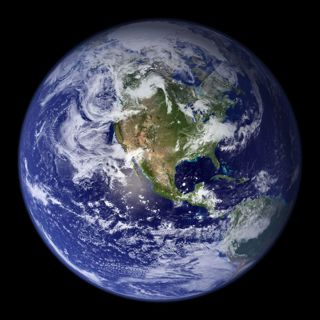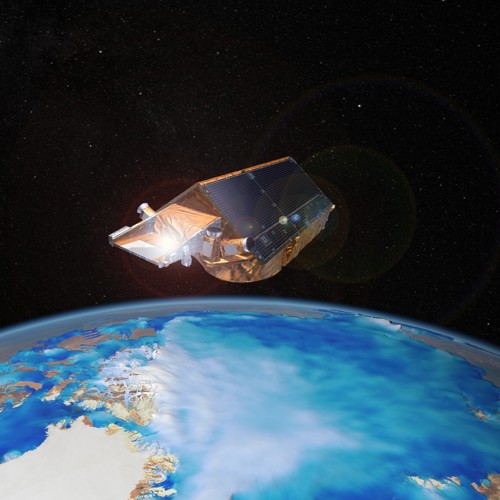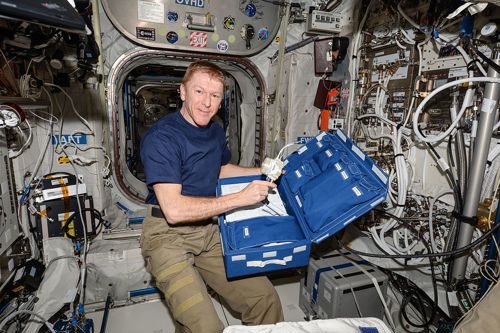
What was all that about?
- 11th Feb 2019
Or, 5 sustainable development goals supported by space science and technology
Dr Kierann Shah - General Manager and Kersti Fourcin - Communucations and Marketing Manager
Monday 11th February marks the United Nations' International Day of Women and Girls in Science. This year the UN have chosen to focus on an Investment in Women and Girls for Inclusive Green Growth. This is part of their drive towards the Sustainable Development Goals (SDGs). The SDGs are a proposed blueprint to achieve a better and more sustainable future for all. They address the global challenges we face, including those related to poverty, inequality, climate, environmental degradation, prosperity, and peace and justice. So what have they got to do with space? The space stories that make the headlines are usually about exploration or outer space, but some of the most powerful daily impacts of space science are about improving life on Earth.
We've chosen five SDGs where space science is making a difference, and we've included some women in science who are helping. This isn't an exhaustive list; there are many more examples out there and new ideas being developed all the time.

1. Climate action
Goal no.13
Take urgent action to combat climate change and its impacts
Satellites let us look at Earth's climate systems and have been vital in helping us to understand the impact of climate change. There are many ways to gather information here on Earth but the use of satellites creates a global perspective and helps us to put all the pieces together.
Earth observation (EO) is a research area which uses satellites to observe the Earth from space using visible light or other parts of the electromagnetic (EM) spectrum. For example, satellite observation can measure polar sea ice and the changing Greenland and Antarctic ice sheets using radar (detection of radio waves). The European Space Agency's (ESA) CryoSat mission has been measuring the height variations of sea ice and sea surface levels in this way since 2010. This is part of ESA's ongoing Living Planet research programme. It has shown us that the pace of ice loss in Greenland is increasing. In many ways CryoSat has been a front-runner in building the case for observable climate change in a way that ground based measurements alone could never match. There are a number of UK researchers working on CryoSat science, like Dr Anna Hoggat the University of Leeds. Anna has been working on ice sheet monitoring from space for her whole research career.

Artist's impression of CryoSat. Credit: ESA, from gov.uk/government/case-studies/cryosat
So, EO satellite data provides an invaluable way of tracking the impact of changes in climate policy. It gives scientists, and everyone else (!) the evidence they need to hold governments to account to tackle the climate crisis. (For context, see the IPCC Special Report on Global Warming of 1.5°C, or the Met Office response and briefing notes). If you're interested, The ESA Copernicus project publishes data from its satellites as part of its open data policy. Check it out here.
2. Zero hunger
Goal no. 2
Roughly one third of the food produced in the world for human consumption every year — approximately 1.3 billion tonnes — gets lost or wasted (fao.org). One of the expected impacts of climate change is disruption to existing farming and food supply. As global temperatures and weather patterns change this will impact on traditional crop growth. Part of working towards 'Zero Hunger' will require maximising farming yields and tackling the challenges of food distribution. Space science can help with both of these.
A specific sector called agritech, applying various technologies to the field of agriculture, can help. For example, satellites using visible and near infrared light can observe the health of crops from space and allow "precision farming" of fertiliser or pesticides. This saves time and money. This video from the UK's Satellite Applications Catapult, who exist to help develop satellite data businesses in the UK, explains more:
Space technology can also help with the supply chain by using satellites to develop transport infrastructure. You can read more about a project doing just this from Senior Earth Observation Scientist, Terri Freemantle, here.
The UK Space Agency's International Partnership Programme funds work by organisations delivering a "sustainable, economic and societal benefit" to developing countries. The agriculturesector is one key area (Space for development).
3. Life below water
Goal no. 14
Conserve and sustainably use the oceans, seas and marine resources
The ocean has a lot in common with space. Extreme environments and the role of international cooperation both spring to mind. Although coastal nations have their "territorial waters" there are great swathes of ocean which belong to no nation individually. Similarly, space cannot be owned by any one nation. Not only because of the practical challenges, but also thanks to the 1967 Outer Space Treaty.
This one can work two ways.
Astrobiologists research the possibility and requirements for life existing elsewhere in the solar system. A greater understanding of extreme deep sea environments has actually benefited space science. Life has yet to be found outside Earth. Extreme environments in the ocean give an insight into how life might develop or survive in another extreme environment; space. In fact, one of the prevailing theories of how life started on Earth is that it was the chemical and energy rich environment created by deep ocean thermal vents that created the niche where life first began (scientificamerican.com).
One of the great things about science is how different fields can help each other. The study of astrobiology has continued to develop the study of Earth based "extremophiles"; microbes that survive in the most extreme environments on Earth. This has developed our understanding of how and why life survives, and how we can use this for the benefit of humans.
Space scientists have also helped to tackle issues around illegal and unregulated fishing. Our friend at Satellite Applications Catapult, Maral Bayaraa, gave us a bit more information on this one:
"Space technologies have the potential to help fulfil the overarching principle 'no one will be left behind' that underlies the UN's SDGs. A fantastic recent achievement is how OceanMind helped Thailand earn their EU 'green card' status again [1][2]. This is just one example of how UK space technology is enabling even the most resource poor nations to protect their oceans by tackling their issues around illegal and unregulated fishing. This particular example allows Thailand to monitor and progress many of their SDGs, including #13,14,16.. It is all because of the unique vantage point that space technologies offer us, allowing us to consistently monitor huge sways of our planet. In other words, space technologies are helpings us to look at the whole of the forest rather than just the trees."
4. Life on land
Goal no. 15
Sustainably manage forests, combat desertification, halt and reverse land degradation, halt biodiversity loss
We've already looked at examples of how satellite data is being used to monitor and affect land for goal number 2: Zero Hunger. The applications are much wider than agriculture.
The Disaster Monitoring Constellation (DMC) is a UK led international collaboration which allows satellites to work together as a group in order to monitor the aftermath of disasters such as earthquakes, landslides, volcanic eruptions and floods. By comparing images from before and after the disasters, we can practice near real-time "change detection" which can be reported to teams on the ground. This could be as simple as mapping where roads are now unusable, to predicting areas that are vulnerable to further disaster.
We couldn't let this one pass by without mentioning robotics. The same approaches that result in rovers exploring Mars are useful for creating autonomous systems for land based activities (there's that agriculture connection again!), or for exploring dangerous environments where it is not safe for humans. RAL Space robotics are one of the Research and Development groups who are working on this.
On Friday 8th February 2019 the space division of Airbus unveiled the name of the new ExoMars rover; Rosalind Franklin. She was an x-ray crystallographer whose images allowed the understanding of the structure of DNA.
In this video, The Delivery Manager for the rover's first build, Abby Hutty, talks about her career and how to attract more people - including introverts - into science and engineering:
5. Good health and well being
(Goal no. 3. AKA Ensure healthy lives and promote well-being for all at all ages)
There are a number of ways that space science can help with this goal, some of them we can use in our own homes! Again, our first few examples are based on satellite applications.
The Satellite Applications Catapult has demonstrated how satellite enabled connectivity can link up people in remote rural communities with doctors. See how, here.
Air quality can be monitored from space too, providing governments with information on where to target pollution, and even recommending when people should avoid busier parts of the city.
With all this focus on satellites, you might think we'd forgotten about the work of astronauts, so here's a great astronaut based link to health and well-being. Understanding muscle atrophy in astronauts,and how to mitigate it with resistance exercises, is useful for understanding muscle atrophy in elderly or injured people. NASA have carried out some impressive experiments in this field.
Likewise, studying the cardiovascular system in a micro-gravity environment is useful for researching heart and blood pressure problems in people on Earth!
"The parallels are so strong that researchers are now taking a closer look at the stabiliser muscles and using 'bed studies' to mirror the effects of microgravity. Bedridden patients are being given lumbar spine and stimuli training and compared with control groups, to see if the strength of the stabiliser muscles can be maintained." (csp.org.uk)

So when astronauts are working on various science experiments on the International Space Station, they are also acting as experimental subjects on human physiology themselves. There is a whole field of "space medicine" devoted to this kind of study. For more about UK interests in space physiology and medicine check out UK Space Labs. Dr Julia Attias is a researcher in the UK Space Labs community whose research into an astronaut "skinsuit" has applications for terrestrial health.
Our last example is one that we can think about in our own homes: space research that has shown that plants can be beneficial for human health and wellbeing. NASA's study on using plants for air filtration "Interior Landscape Plants for Indoor Air Pollution Abatement" is 30 years old but is still seen as the most important study in this area. NASA have been deploying humans in space since the 1960s. As mission duration has increased over time the question of how to maintain air quality in an enclosed environment has become more important. NASA's study looked into which common air pollutants could be filtered out by different plants, and made some recommendations for the best plants to use in office environments (see this infographic put together by lovethegarden.com)

Astronauts have also talked about the psychological importance of green spaces and plants. British ESA astronaut Tim Peake said that the colour green, and fresh air, were two of the things he missed most when living on the International Space Station. This is echoed by other astronauts and supports the idea that humans benefit from being in green spaces and the countryside.
Sometimes it takes an extreme situation to help us see the bigger picture.
What was all that about?
Space is a great demonstrator of international collaboration. Projects that cross boundaries show us how nations can work together to solve problems on Earth. Increasing communication, allowing greater amounts of data to be shared and exchanging ideas to understand what that data is telling us... It is more important than ever for young people to study STEM subjects; to build a wider understanding of the sector's potential in order to improve our use of space technologies and maximise their impact. We need the next generation (maybe that's you reading this!) to get inspired by science and build on that inspiration to help us achieve a more sustainable future. The whole world must work together.
Happy International Day of Women and Girls in Science!
Dr Kierann Shah and Kersti Fourcin

Further reading, watching and learning...
See how CryoSat and Sentinel satellite data provide an insight into how canyons under the Antarctic ice shelf are affecting the sea ice here
More information on ESA's Living Planet programme here
Read more about Satellite Application Catapult's work to combat Illegal fishing
NASA LandSat baselining for other EO missions such as how 'Loss of Intertidal Ecosystem Exposes Coastal Communities'
Surrey Satellite Technology Ltd is a sector leader in the UK on small satellites operation and the use of satellite data (see more on SSTL here)
An article in Nature Geoscience (2018) about measuring ice sheets
#WomenInScience
